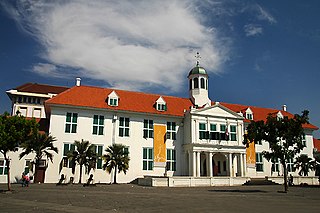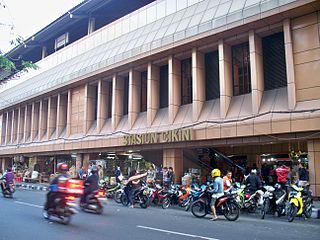
Jakarta, officially the Special Capital Region of Jakarta, is the capital and largest city of Indonesia. Lying on the northwest coast of Java, the world's most populous island, Jakarta is the largest city in Southeast Asia, and serves as the diplomatic capital of ASEAN. The city is the centre of the economy, culture, and politics of Indonesia. It has a province level status which has a population of 10,562,088 as of 2020. Although Jakarta extends over only 664.01 square kilometres (256.38 sq mi), and thus has the smallest area of any Indonesian province, its metropolitan area covers 9,957.08 square kilometres (3,844.45 sq mi), which includes the satellite cities Bogor, Depok, Tangerang, South Tangerang, and Bekasi, and has an estimated population of 35 million as of 2021, making it the largest urban area in Indonesia and the second-largest in the world. Jakarta ranks first among the Indonesian states in human development index. Jakarta's business opportunities, and its ability to offer a potentially higher standard of living than is available in other parts of the country, have attracted migrants from across the Indonesian archipelago, making it a melting pot of numerous cultures.

The Merdeka Palace, is one of six presidential palaces in Indonesia. It is located on the north side of the Merdeka Square in Central Jakarta, Indonesia and is used as the official residence of the President of the Republic of Indonesia.

Raden Saleh Sjarif Boestaman was a pioneering Indonesian Romantic painter of Arab-Javanese ethnicity. He was considered to be the first "modern" artist from Indonesia, and his paintings corresponded with nineteenth-century romanticism which was popular in Europe at the time. He also expressed his cultural roots and inventiveness in his work.

Menteng is the south-central district of Central Jakarta, one of the administrative municipalities in the capital city Jakarta, Indonesia.

Sawah Besar is a district (kecamatan) of Central Jakarta, Indonesia. Its neighborhoods are among the most historic, containing the 1820-established Pasar Baru, the new colonial city – Weltevreden – and the old course of the Ciliwung river. Landmarks include the Lapangan Banteng, the government's 19th century-built, low-rise A.A. Maramis Building and its high palmed-lawned vista, and Jakarta Cathedral.

Jakarta is Indonesia's capital and largest city. Located on an estuary of the Ciliwung River, on the northwestern part of Java, the area has long sustained human settlement. Historical evidence from Jakarta dates back to the 4th century CE, when it was a Hindu settlement and port. The city has been sequentially claimed by the Indianized kingdom of Tarumanegara, the Hindu Kingdom of Sunda, the Muslim Sultanate of Banten, and by Dutch, Japanese and Indonesian administrations. The Dutch East Indies built up the area before it was taken during World War II by the Empire of Japan and finally became independent as part of Indonesia.

The Ministry of Foreign Affairs of the Republic of Indonesia or commonly known by its abbreviations as "Kemlu" or "MoFA", is an Indonesian government ministry responsible for the country's foreign politics and diplomacy. The ministry was formerly known as the Department of Foreign Affairs, until 2008 when the nomenclature changed with the enactment of the 2008 State Ministry Act.

Dutch colonial architecture in Indonesia were built across the archipelago that once was known as Dutch East Indies. Most of the better and permanent colonial era structures are located in Java and Sumatra, which were economically considered more important during the Dutch imperial period. As a result, there are large number of colonial buildings concentrated in its cities. Plenty of old VOC era forts and warehouses are also scattered throughout the archipelago, particularly around Maluku Islands and Sulawesi. There are three Dutch colonial architectural styles:

Colonial buildings and structures in Jakarta include those that were constructed during the Dutch colonial period of Indonesia. The period succeeded the earlier period when Jakarta, governed by the Sultanate of Banten, were completely eradicated and replaced with a walled city of Batavia. The dominant styles of the colonial period can be divided into three periods: the Dutch Golden Age, the transitional style period, and Dutch modernism. Dutch colonial architecture in Jakarta is apparent in buildings such as houses or villas, churches, civic buildings, and offices, mostly concentrated in the administrative city of Central Jakarta and West Jakarta.
Ismail Marzuki Park,, is an arts, cultural, and science center located at Cikini in Jakarta, Indonesia. Taman Ismail Marzuki complex comprises a number of facilities including six performing arts theaters, cinemas, exhibition hall, gallery, libraries and an archive building. The complex is built on an 9 hectares land area, which was previously a zoo. TIM is named after Ismail Marzuki, one of Indonesia's most influential composers.
Frans Johan Louwrens Ghijsels was a Dutch architect and urban planner who worked in the Netherlands and the Dutch Indies. Ghijsels was the founder of AIA, the biggest architecture consultant in the Dutch Indies. He was one of the instrumental architect in developing a modern style characteristic of the Dutch Indies.
Kebon Sirih is the northernmost administrative village of Menteng district of Jakarta. It has a postal code of 10340. Kebon Sirih is located to the south of Monas - a historic administrative center of Jakarta - and to the north of Menteng Residential Area - a heritage garden city. The boundary is Jalan KH Wahid Hasyim-Jalan Johar, Jalan Pengarengan to the south, Ciliwung River to the east, Jalan Kebon Sirih to the north, and Jalan Kampung Bali I. 33-Terusan Kebon Sirih 14 to the west.

Jalan M.H. Thamrin or Jalan Thamrin is a major thoroughfare in Jakarta, Indonesia. The road is located at the center of Jakarta, running from the north end of Jalan Jenderal Sudirman at West Flood Canal at the south end to the roundabout near Arjuna Wijaya Statue Jakarta at the north end. Developed in the 1950s, the road was a landmark of post-colonial Indonesia and continues to have a prominent importance in Jakarta.

The Kunstkring Art Gallery is a heritage building located in Central Jakarta, Indonesia. Built in 1914, following the design of Dutch architect P.A.J. Moojen, it originally housed the local art circle. After several changes of use, in 2011 the building has been restored, with the upper floor used as an art gallery while the ground floor has been converted into a restaurant.
Gatot Soebroto Army Hospital is a hospital in Jakarta, Indonesia. The name of the hospital is derived from Gatot Soebroto, a National Hero of Indonesia. Established in 1819, the hospital is the main hospital for the Indonesian Army. The hospital also provides limited services for civilians.
Pieter Adriaan Jacobus "Piet" Moojen was a Netherlands-Indies architect, painter and writer. He studied architecture and painting in Antwerp. He lived and worked in the Dutch East Indies from 1903 to 1929. He was one of the first architects to implement Modernism in the Dutch East Indies. Moojen became widely known for his work on the Dutch entry at the Paris Colonial Exposition in 1931. He was active as an architect between 1909 and 1931.

Cikini Station is a railway station located on Jl. Cikini Raya, Cikini, Menteng, Central Jakarta. This station is only served by KRL Commuterline commuter trains from Jakarta Kota to Depok, Bogor, Bekasi and Cikarang.

Masjid Jami' Al-Makmur Cikini is located on Jalan Raden Saleh Raya in Cikini, Central Jakarta, and is one of the oldest mosques in the locality. It was formerly known as Tjikini Mosque.

Cikini Hospital, also known as PGI Cikini Hospital, Rumah Sakit Cikini, is a hospital in Cikini, Menteng in Jakarta, Indonesia. It was formerly a mansion that was designed by Indonesian painter Raden Saleh, who used it as residence. Use of it as a hospital and nursing academy began in 1898. The building was built in 1852 and is known for its park-like setting in busy Jakarta, and was home to antelope until they were removed in the early 1970s. Saleh once had a collection of wild animals on the property. It has design features similar to the Callenberg Castle.

Indies Empire style is an architectural style that flourished in the colonial Dutch East Indies between the middle of the 18th century and the end of the 19th century. The style is an imitation of neoclassical Empire Style which was popular in mid-19th-century France. Conformed to the tropical setting of Indonesia, the style became known in the Dutch East Indies as Indies Empire style.














